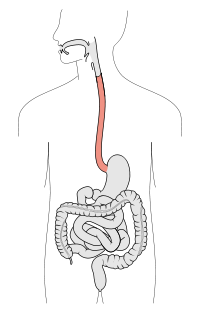
Photo from wikipedia
OBJECTIVE To characterize a population of dogs presenting for esophageal foreign body removal and evaluate factors associated with degree of esophagitis and minor and major complications. DESIGN Retrospective evaluation of… Click to show full abstract
OBJECTIVE To characterize a population of dogs presenting for esophageal foreign body removal and evaluate factors associated with degree of esophagitis and minor and major complications. DESIGN Retrospective evaluation of dogs who presented for esophageal foreign body removal between January 2004 and December 2014. SETTING University veterinary teaching hospital. ANIMALS Data collected from 114 dogs included signalment, history, clinical signs, physical examination findings, duration and location of foreign body, degree of esophagitis, foreign body removal success, feeding tube placement, and clinical outcomes. Owners were contacted for outcome data not available in the medical record. Data were analyzed for breed predispositions, whether duration or type of foreign body was associated with degree of esophagitis or complications, and factors associated with feeding tube placement. INTERVENTIONS None. MEASUREMENTS AND MAIN RESULTS The overall success rate for foreign body removal via esophagoscopy was 95% with a complication rate of 22%. Small breed dogs were overrepresented. Dogs with a foreign body present for >24 h were significantly more likely to have severe esophagitis (P < 0.001) and major complications (P = 0.0044). Foreign body type did not predict degree of esophagitis or complications, though fishhooks were more likely to require surgical removal (P = 0.033). Feeding tubes (15 gastrostomy, 1 nasoesophageal) were placed in 14% of dogs and were more likely to be placed if the foreign body had been present for >24 h (P < 0.001). CONCLUSIONS Consistent with previous studies, esophageal foreign bodies, appropriately identified and endoscopically removed, carry a good prognosis, particularly if they have been present for ≤24 h.
Journal Title: Journal of veterinary emergency and critical care
Year Published: 2019
Link to full text (if available)
Share on Social Media: Sign Up to like & get
recommendations!